Analysis of monthly variability of thermocline in the South China Sea*
2018-05-07PENGHanbang彭汉帮PANAijun潘爱军ZHENGQuanan郑全安HUJianyu胡建宇
PENG Hanbang (彭汉帮) PAN Aijun (潘爱军) ZHENG Quan’an (郑全安) HU Jianyu (胡建宇)
1 State Key Laboratory of Marine Environmental Science, College of Ocean and Earth Sciences, Xiamen University, Xiamen 361102, China
2 Ocean Dynamics Laboratory, the Third Institute of Oceanography, State Oceanic Administration (SOA), Xiamen 361005, China 3 Department of Atmospheric and Oceanic Science, University of Maryland, College Park 20742, USA
1 INTRODUCTION
A thermocline is defined as a transition layer between the warmer mixed water of the upper ocean and the cooler subsurface water below. Its spatiotemporal variations can greatly influence climate change, marine fishery and underwater communication.As a semi-closed basin, the South China Sea (SCS)lies in the East Asian monsoon region (Fig.1) and the study area for this paper is deeper than 200 m.Previous investigators have carried out studies on the spatio-temporal variations of the thermocline, mainly focusing on seasonal variation of the thermocline depth. Liu et al. (2001) found that the thermocline in the central SCS becomes deeper and thinner in winter.Based on the global observational dataset MOODS(Master Observational Oceanographic Data Set) and the Generalized Digital Environmental Model(GDEM), Lan et al. (2006) investigated the thermocline depth in the SCS and found that, in January (winter), the thermocline in the northwestern SCS is deeper than that in the southeast, with two shallower centers located in the northwest of the Luzon Island and the Kalimantan Island, and in April(spring), the thermocline depth is about 30 m almost in the entire SCS. In July and October (summer and autumn), however, the thermocline depth in the northwestern SCS is shallower than that in the southeast. According to the Simple Ocean Data Assimilation (SODA) data in the SCS, Fang et al.(2013) obtained the similar seasonal variation results of the thermocline depth as Lan et al. (2006), indicating that the SODA data, though a global product, are suitable for studying the thermocline in the SCS.
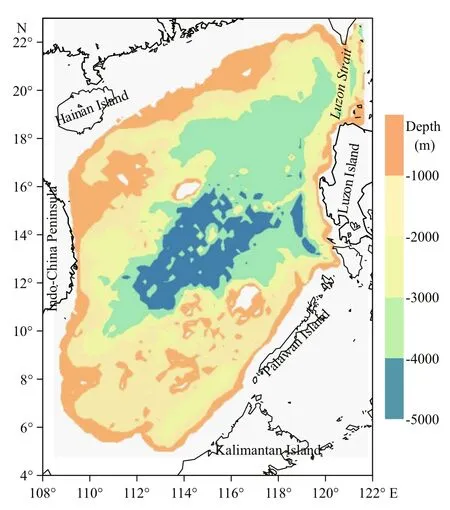
Fig.1 Topography of the South China Sea
Regarding the mechanism for the seasonal variation of thermocline depth, Liu et al. (2000), and Zhou and Gao (2001) suggested that local wind stress can affect the thermocline through Ekman pumping. Liu et al.(2001) pointed out that the variation of the thermocline is mainly induced by the seasonal cycle of heat flux and wind stress. Besides, Lan et al. (2006) put forward that the ocean circulation and multi-eddy structure in the SCS have significant effects on the thermocline variability. Hao et al. (2012) regarded the surface buoyancy flux (caused by net heat flux and fresh water flux) and the wind stress as the main mechanisms for the seasonal variability of the thermocline.
Although the thermocline depth in the SCS in some seasonal months (January, April, July and October)have been investigated, the thermocline depth in the other months remains unclear, which is our motivation to investigate the monthly evolution of the thermocline depth in the SCS. The lower boundary depth (Zlow),the thickness (ΔZ) and the intensity (Tz) of the thermocline in the SCS and the monthly variability of them have rarely been studied. In this study, we use 51-years (1960–2010) monthly seawater temperature data of SODA (Carton et al., 2000a, b, 2005) to calculate the upper boundary depth of thermocline(Zup),Zlow, ΔZandTzin the SCS, focusing on their monthly variability and the mechanisms of monthly variability ofZup. It is clear that this monthly variability study of thermocline in the SCS can be worthwhile,for example, for regional modellers who would like to benchmark their own results against those from a global product. However, in order to avoid too long a text, we only describe the odd-monthly means of the thermocline parameters and the mechanisms.
The paper is organized as follows: Data and analysis methods are shown in Section 2. Monthly variability of the thermocline in the SCS is presented in Section 3. Mechanisms of the monthly variability ofZupare discussed in Section 4, and the conclusions and discussion are listed in Section 5.
2 DATA AND METHOD
2.1 Data
The monthly seawater temperature, sea surface salinity and wind stress products of SODA (Carton et al., 2000a, b, 2005) are used for calculations of the thermocline, the sea surface buoyancy flux and the wind stress curl, respectively. The ocean data assimilation model is based on observations including virtually all available hydrographic profile data, as well as ocean station data, mooring temperature and salinity time series, surface temperature and salinity observations of various types. The basic temperature and salinity observation sets consist of approximately 7×106profiles over the global ocean, of which two thirds have been obtained from the World Ocean Database 2009 (Giese and Ray, 2011). Output variables are averaged every five days, and then mapped onto a uniform global 0.5°×0.5° horizontal grid (a total of 720×330×40-level grid points),spanning the latitude range from 79.25°S to 89.25°N and the longitude range from 179.75°W to 179.75°E,using the horizontal grid spherical coordinate remapping and interpolation package (Carton and Giese, 2008). We download 50×50 profiles that bounded by 0.25°–24.75°N and 100.25°–124.75°E and use 470 profiles in which the depth in the SCS is deeper than 200 m (Fig.1), and we download the upper 25 vertical layers of the seawater temperature,i.e., 5, 15, 25, 35, 46, 57, 70, 82, 97, 112, 129, 149,171, 198, 229, 268, 317, 381, 465, 579, 729, 918,1 140, 1 378, and 1 625 m. The version of SODA used in our study is SODA v2.2.4 (Giese and Ray,2011) and the variables include ocean temperature(including sea surface temperature (SST)) (°C),salinity, horizontal and vertical ocean velocity (m/s),sea level (m) and wind stress (N/m2).
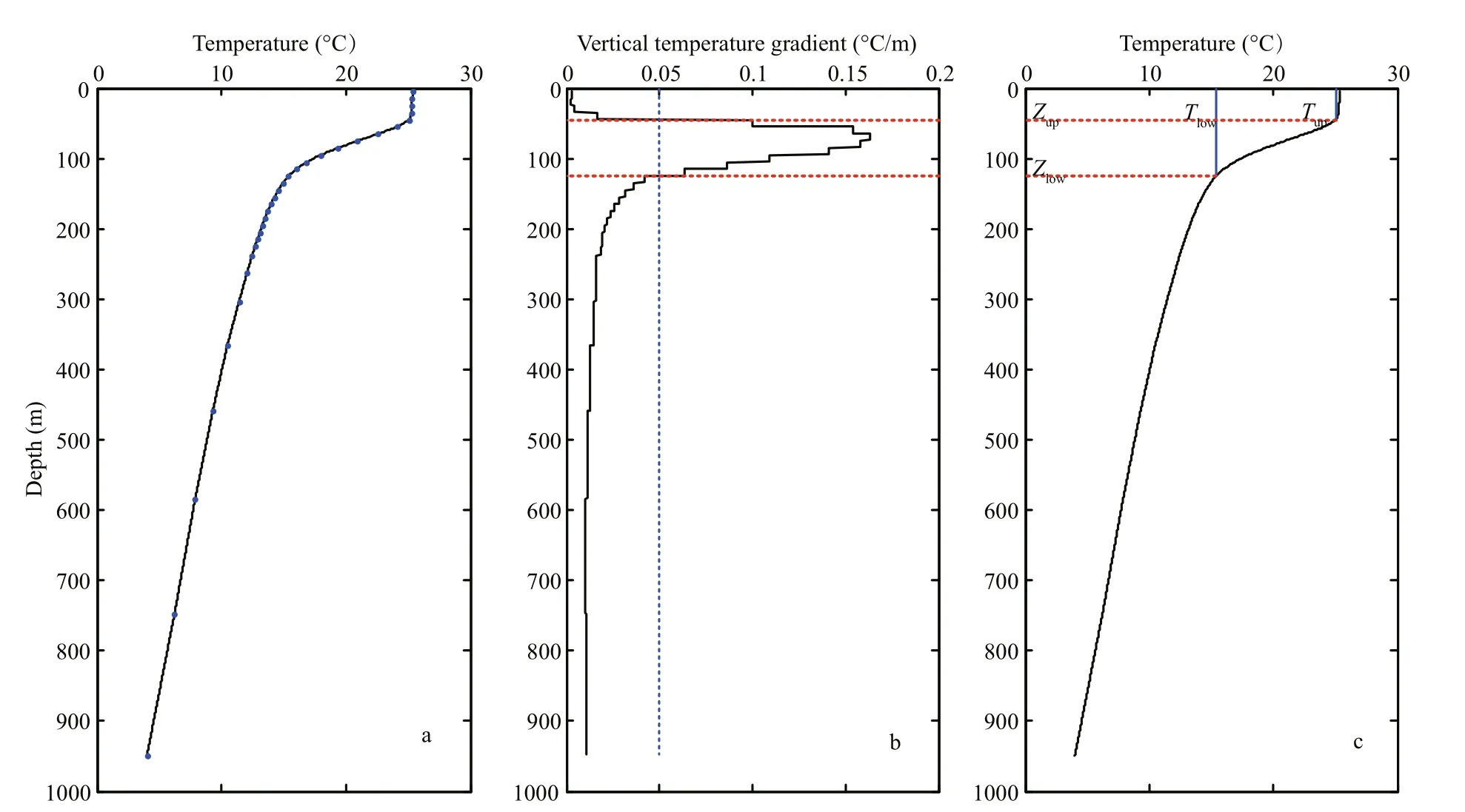
Fig.2 Procedures for determining thermocline
The monthly net long wave radiation, net short wave radiation, sensible heat flux and latent heat flux data (1960–2010, 1.875°×1.875°) used for the sea surface net heat flux calculation are downloaded from the National Centers for Environmental Prediction(NCEP) reanalysis (Kalnay et al., 1996) (ftp://ftp.cdc.noaa.gov/Datasets/ncep.reanalysis.derived/surface_gauss/). Monthly precipitation (1960–2010,2.5°×2.5°) and evaporation data (1960–2010, 1°×1°)used for the sea surface buoyancy flux calculation are downloaded from the National Oceanic and Atmospheric Administration (NOAA)’s Precipitation Reconstruction (PREC) Dataset (Chen et al., 2002)(http://www.esrl.noaa.gov/psd/data/gridded/data.prec.html)and the Objectively Analyzed air-sea Fluxes (OAFlux)project (Yu et al., 2008) of Woods Hole Oceanographic Institution (WHOI) (ftp://ftp.whoi.edu/pub/science/oaflux/data_v3/monthly/evaporation/), respectively.The oceanic precipitation analysis (PREC/O) is produced by EOF (Empirical Orthogonal Function)reconstruction of historical gauge observations over islands and land areas and the OAFlux project uses the objective analysis to obtain optimal estimates of flux-related surface meteorology and then computes the global fluxes by using the state-of-the-art bulk flux parameterizations.
2.2 Method
There are several methods to determine the thermocline, such as using the quasi-step-function approximation (QFA) (Ge et al., 2003), the 20°C isotherm and the vertical temperature gradient criterion (GC) methods. However, the QFA method cannot be applied to the region off the shelf (Hao et al., 2008). The 20°C isotherm method takes the depth of the 20°C isotherm as the thermocline depth. On the other hand, the GC method defines the thermocline to be the layer with the vertical gradient of temperature continuously larger than a given value (Fig.2), which can not only determine the upper boundary depth but also the lower boundary depth of thermocline and is properly used off the shelf (Hao et al., 2012).Therefore, we use the GC method to determine thermocline in this study. The gradient criterion of thermocline is 0.05°C/m (CSBTS, 2008).
We define thermocline intensityTzas

whereTupandTloware the temperatures ofZupandZlow,respectively.
The surface net heat flux is calculated by

whereQis net heat flux and a positive value means absorption of heat by seawater,Q1,Q2,Q3andQ4are the net short wave radiation, net long wave radiation,latent heat flux and sensible heat flux, respectively.
The buoyancy fluxB(kg/(m∙s3)) is calculated by

whereBqis the thermal buoyancy due to the net heat flux,Bpis the haline buoyancy due to the net fresh water flux, g is the gravitational acceleration (9.8 m/s2)and Δρis the variation of seawater density,Qis the net heat flux (downward positive; W/m2),ρis the reference water density (1 024 kg/m3) andCpis the specific heat of water (3 986.3 J/(kg∙°C)) (Fofonoffand Millard, 1983), α is the thermal coefficient of expansion (1.7×10-4/°C) and β is the coefficient of unit haline contraction (7.5×10-4) (McDougall, 1987),S0,E, andPare surface salinity, evaporation and precipitation, respectively.
The wind stress curlτc(N/m3) is defined as

whereτxandτy(N/m2) are zonal and meridional wind stress, respectively.
3 MONTHLY VARIABILITY OF THE THERMOCLINE
3.1 Spatial distribution of thermocline parameters
3.1.1 Upper boundary depth
The odd-monthly distribution of upper boundary depthZupin the SCS is shown in Fig.3a–f. One can see that in January,Zupin the northwestern SCS is 50–120 m, which is deeper than that in southeast (30–50 m), with two shallower centers (<40 m) located in the northwest of the Luzon Island and the Kalimantan Island, respectively. In March (Fig.3b),Zupbecomes shallower than that in January and continues to shoal in most regions in May (Fig.3c). On the contrary to January,Zupstarts to deepen in July (Fig.3d). It becomes deeper in the southeastern SCS (30–50 m)than that in the northwestern SCS (10–30 m), and continues to deepen in September (Fig.3e). The distribution patterns are the same as that in July with a shallower center (<20 m) located in the east of the Indo-China Peninsula. In November (Fig.3f),Zupbecomes deeper than that in September in the northwestern SCS, but shallower in the southwestern SCS.
3.1.2 Lower boundary depth
The odd-monthly distribution of lower boundary depthZlowin the SCS is shown in Fig.3g–l. In January(Fig.3g),Zlowis about 150–190 m in the northwestern SCS and about 150–180 m in the southeastern SCS.In March (Fig.3h),Zlowin western SCS is 160–180 m,which is deeper than that in east (140–160 m). In May(Fig.3i),Zlowis between 150 and 170 m in most areas,showing a homogeneous distribution. In July (Fig.3j),Zlowin the northwestern SCS is 130–160 m, which is shallower than that in the southeastern SCS (160–190 m). In September (Fig.3k),Zlowin the northwestern SCS with a shallower center (120–150 m) east of the Indo-China Peninsula is shallower than that in the southeastern SCS. In November (Fig.3l),Zlowin northwestern SCS becomes deeper than that in September.
3.1.3 Thickness
The odd-monthly distribution of thickness ΔZin the SCS is shown in Fig.3m–r. In January (Fig.3m),ΔZis from 120 m to 150 m in the east of the Indo-China Peninsula, while ΔZis smaller than 110 m in most regions. In March (Fig.3n), ΔZincreases about 20 m in the areas between the Indo-China Peninsula and the Luzon Island, and about 10 m in the southern SCS in comparison with that in January. In May(Fig.3o), ΔZis between 140 m and 160 m in most regions, exhibiting a homogeneous distribution feature. In July (Fig.3p), ΔZin the northeastern SCS is 140–160 m, which is a little thicker than that in the southwestern SCS (120–140 m) with a small thinner center (<120 m) west of the Palawan Island. In September (Fig.3q) and November (Fig.3r), ΔZis generally thinner than that in July.
3.1.4 Intensity
The odd-monthly distribution of intensityTzin the SCS is shown in Fig.3s–x. In January (Fig.3s), from the continental shelf break of the northern SCS to the central SCS,Tzgradually increases from 0.06 to 0.10°C/m. In comparison to January,Tzgenerally becomes weaker than that in January. In May (Fig.3u),Tzin the northwestern SCS is between 0.08 and 0.09°C/m, which is weaker than that in the southeastern SCS (0.09–0.11°C/m). In July (Fig.3v),Tzis between 0.08 and 0.10°C/m in most regions. In September (Fig.3w),Tzis generally stronger than that in July, especially east of the Indo-China Peninsula.In November (Fig.3x), the values ofTzare widely smaller than that in September.
3.2 Spatial means of thermocline parameters
In order to analyze the monthly variability ofZup,Zlow, ΔZandTz, we calculate their spatial means and the standard deviations as shown in Fig.4. One can see thatZupis the deepest in January (about 54 m) and the shallowest in May (about 17 m) (Fig.4a, blue bars). It increases gradually by approximately 5.4 m from May to the January of the following year, and decreases by about 12 m from February to May. On the other hand,Zlowremains 162 m (±2 m) throughout the whole year (Fig.4a, green bars). Monthly variability of ΔZ, shown as light purple bars in Fig.4b,is in antiphase withZup. It is thickest in May (about 148 m) and thinnest in January (about 110 m).
The spatial mean and the standard deviation of monthlyTzvalues are shown as orange bars in Fig.4b. One can see thatTzis weakest in March(0.07–0.08°C/m) but strongest in September (0.09–0.10°C/m).Tzgradually strengthens from March to September, but weakens from September to the following March.
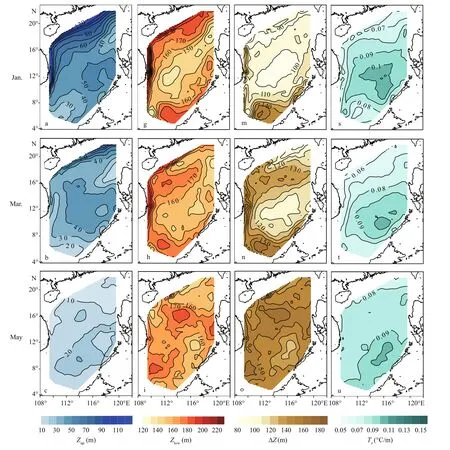
Fig.3 Climatologically odd-monthly mean Z up (a to f), Z low (g to l), Δ Z (m to r) and T z (s to x) from January to November To be continued
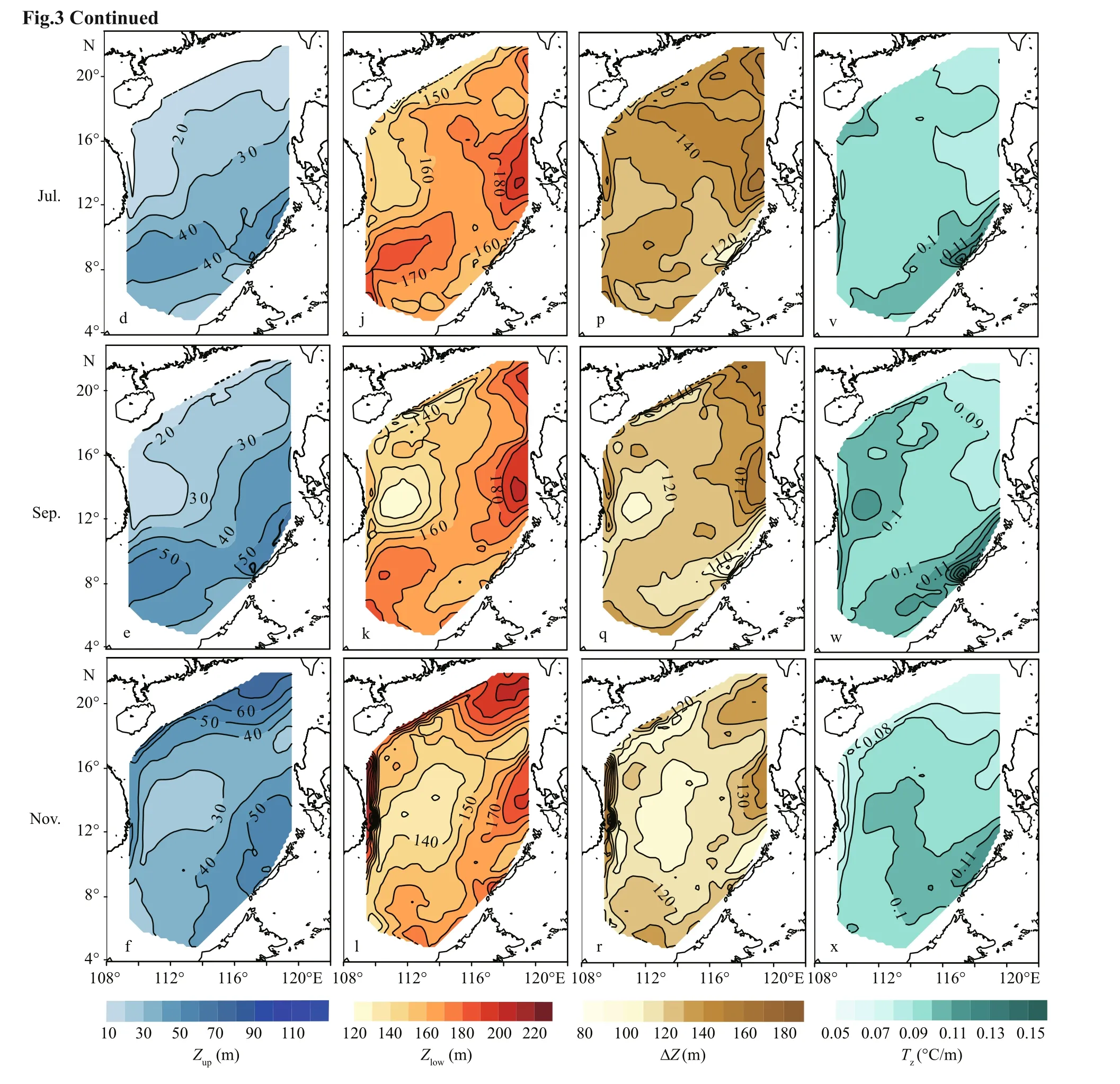
Fig.3 Climatologically odd-monthly mean Z up (a to f), Z low (g to l), Δ Z (m to r) and T z (s to x) from January to November
4 MECHANISMS OF MONTHLY VARIABILITY OF Z up
4.1 Factors influencing monthly variability of Z up
In this section, we investigate the physical processes responsible for the monthly variability ofZup. Previous studies have revealed that surface net heat flux and wind stress play important roles in seasonal variation of the thermocline depth. Heat and fresh water flux at the sea surface may change the stability of upper layer stratification, thus aff ectingZup. The sea surface buoyancy consists of the thermal buoyancy (caused by the net heat flux) and the haline buoyancy flux (caused by the fresh water flux). The buoyancy flux, a comprehensive index of thermodynamics, reflects the coherent role of air-sea heat and haline exchanges (Gill, 1982; Schmitt et al.,1989). Wind stress curl also affects the thermocline depth through Ekman pumping. Besides,Zupis inseparable from the lower boundary of mixed layer.Lozovatsky et al. (2005) suggested that the sea surface buoyancy and the wind stress are the main driving mechanisms leading to the mixed layer variation in the North Atlantic Ocean. Based on this analysis we examine connections ofZupto the buoyancy flux and the wind stress curl over the SCS.
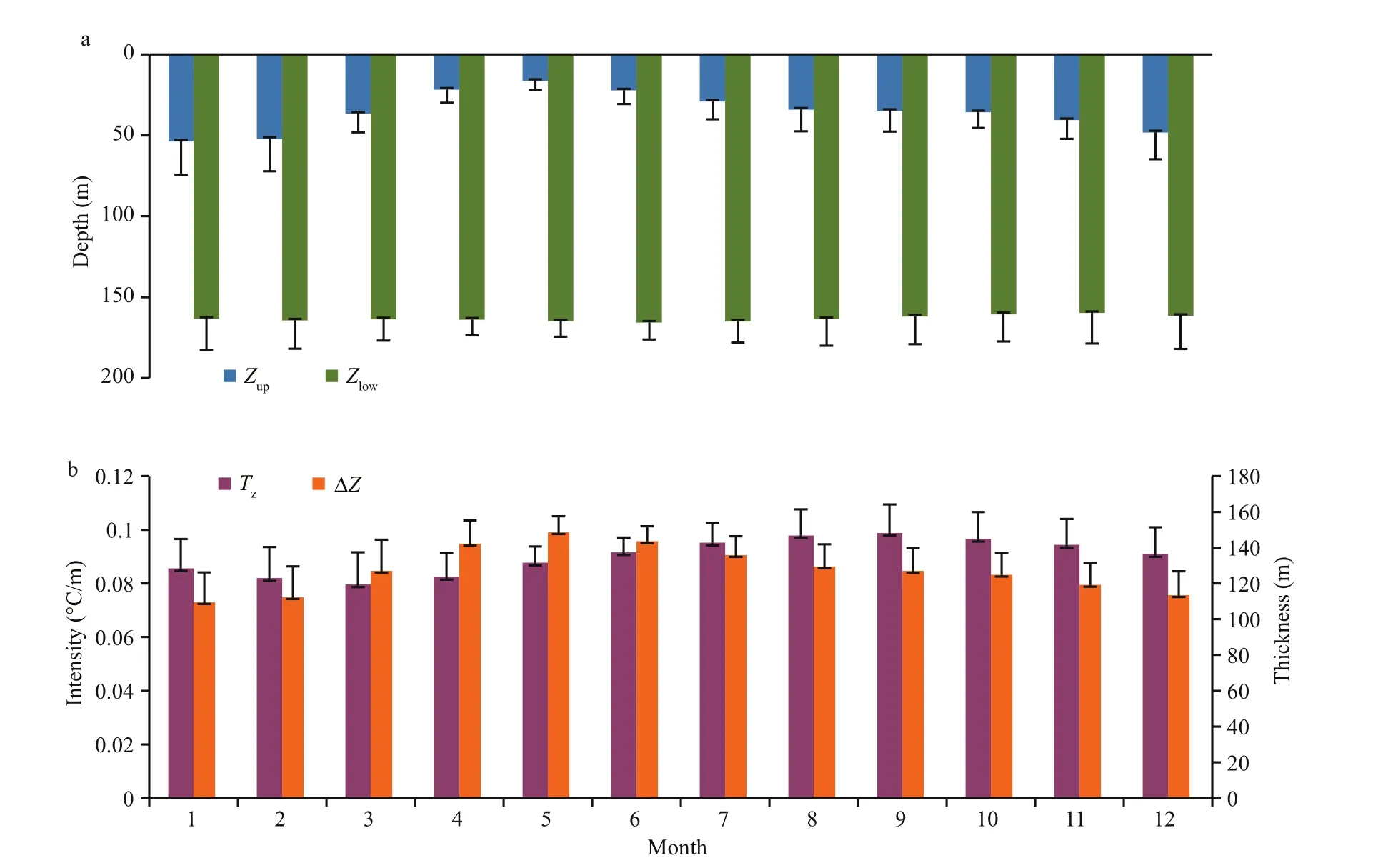
Fig.4 Monthly distributions of spatial means

Table 1 Correlation coefficients of Z up to B and τ c of monthly spatial mean
4.2 Relationships of Z up with buoyancy flux and wind stress curl
According to Eq.3, the variation of the sea surface buoyancy flux (B) depends on the variability of seawater density (Δρ). IfBis positive, i.e., the loss of buoyancy for surface seawater, then the seawater density increases and the seawater will decline, so thatZupwill deepen without regarding to the other outside forces. IfBis negative, the seawater density decreases andZupshoals. In the case ofB=0, the buoyancy flux does not affect the thermocline. On the other hand, the wind stress also drives the movement of seawater. The positive wind stress curl (τc, Eq.4) can generate the cyclonic vorticity on the sea surface and then the upwelling, which can lift the thermocline. On the contrary, the negative wind stress curl can generate the anticyclonic vorticity on the sea surface and then the down welling, which can sink the thermocline. To sum up,Zupdeepens whileBis positive orτcis negative,and shoals whileBis negative orτcis positive.
4.3 Interpretation of monthly variability of Z up
4.3.1 Qualitative analysis
Based on the relationships ofZupwithBandτc, we examine the correlation ofZuptoBandτc. The results indicate thatZuphas positive correlation withBand negative correlation withτc.Zuppresents the best correlation with one-month-advancedBand twomonth-advancedτc, with the correlation coefficient being 0.90 and -0.73 (Table 1), respectively.Accordingly, we conduct a comparative analysis of odd-monthlyZup(January to November, Fig.3a–f)with even-monthlyB(December to the following October, Fig.5a–f) and odd-monthlyτc(November to the following September, Fig.5g–l).
On the continental shelf break of the northern SCS,Breaches a positive maximum in December (Fig.5a)andτcdemonstrates a larger negative value in November (Fig.5g), causing the deepestZupin January(Fig.3a). As for the two shallower centers northwest of the Luzon Island and the Kalimantan Island, they are mainly resulted from the largest positiveτcand both the negativeBand positiveτc, respectively.
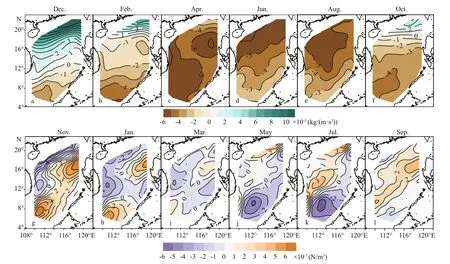
Fig.5 Climatologically monthly means of the buoyancy flux in even months (a to f is December to the following October) and τ c in odd months (g to l is November to the following September)
In February (Fig.5b),Bis smaller than that in December, with a negative value in most areas, so thatZupin March (Fig.3b) is shallower than that in January.Meanwhile, the two shallower centers ofZupbecome shallower due to the positiveτc(Fig.5h).
In May,Zup(Fig.3c) is the shallowest throughout the whole year, mainly owing to the larger negativeBin April (Fig.5c), which plays a dominant role in comparison withτcbecause of the small |τc| (Fig.5i).
In July and September,Zup(Fig.3d, e) in the northwestern SCS is shallower than that in the southeastern SCS. This is becauseBin the northeastern SCS is smaller than that in the southeastern SCS in June and August (Fig.5d, e), whileτcis positive in the northwestern SCS and larger negative in the southeastern SCS in May and July (Fig.5j, k).
In October, positiveB(Fig.5f) in the northernmost study region results in the deeperZupin November(Fig.3f). In the region between the northwest of the Kalimantan Island and the west of the Luzon Island,τcis positive and a little less than zero (Fig.5l) on either side of that region. All of these values lead to the fact thatZupin the northern and southeastern SCS is deeper than that in the other areas (Fig.3f).
4.3.2 Quantitative interpretation
From the above qualitative analyses, the buoyancy flux and the wind stress curl can well account for the monthly variability ofZup. In order to analyze the influence level of the buoyancy flux and the wind stress curl onZup, we explore the relationships ofZupto the buoyancy flux or the wind stress curl without considering the wind stress curl (|τc|<1×10-9N/m3,close to zero) or the buoyancy flux (|B|<1×10-7kg/(m·s3),close to zero), respectively. From the linear regression of their results (Fig.6), it is evident thatZupshows direct proportion to the increasingB, but inverse proportion to the increasingτc. Their empirical relations are given by Eqs.5 and 6, whereZup_BandZup_τcdenote the variations ofZuponly resulted fromBandτc, respectively. From Eq.5,Zupdeepens from 4.2 m to 5.0 m (mean 4.6 m), ifBincreases by 1×10-5kg/(m·s3) without regardingτc. From Eq.6,however,Zupshoals from 1.9 m to 3.1 m (mean 2.5 m),ifτcincreases by 1×10-7N/m3without takingBinto account. In addition,Zupis 45 m without considering eitherBorτcaccording to Eqs.5 and 6, resulting in the linear relationship ofZuptoBandτcas expressed in Eq.7. Figure 7 describes the odd-monthly mean ofZupresulted from Eq.7. The patterns and values (Fig.7a–f)are very similar and close to theZupas shown in Fig.3a–f, expect in May whenZupresulted from Eq.7 is about 25–30 m (Fig.7c), which is larger thanZupresulted from SODA (10–15 m) (Fig.3c) in the northwestern SCS.
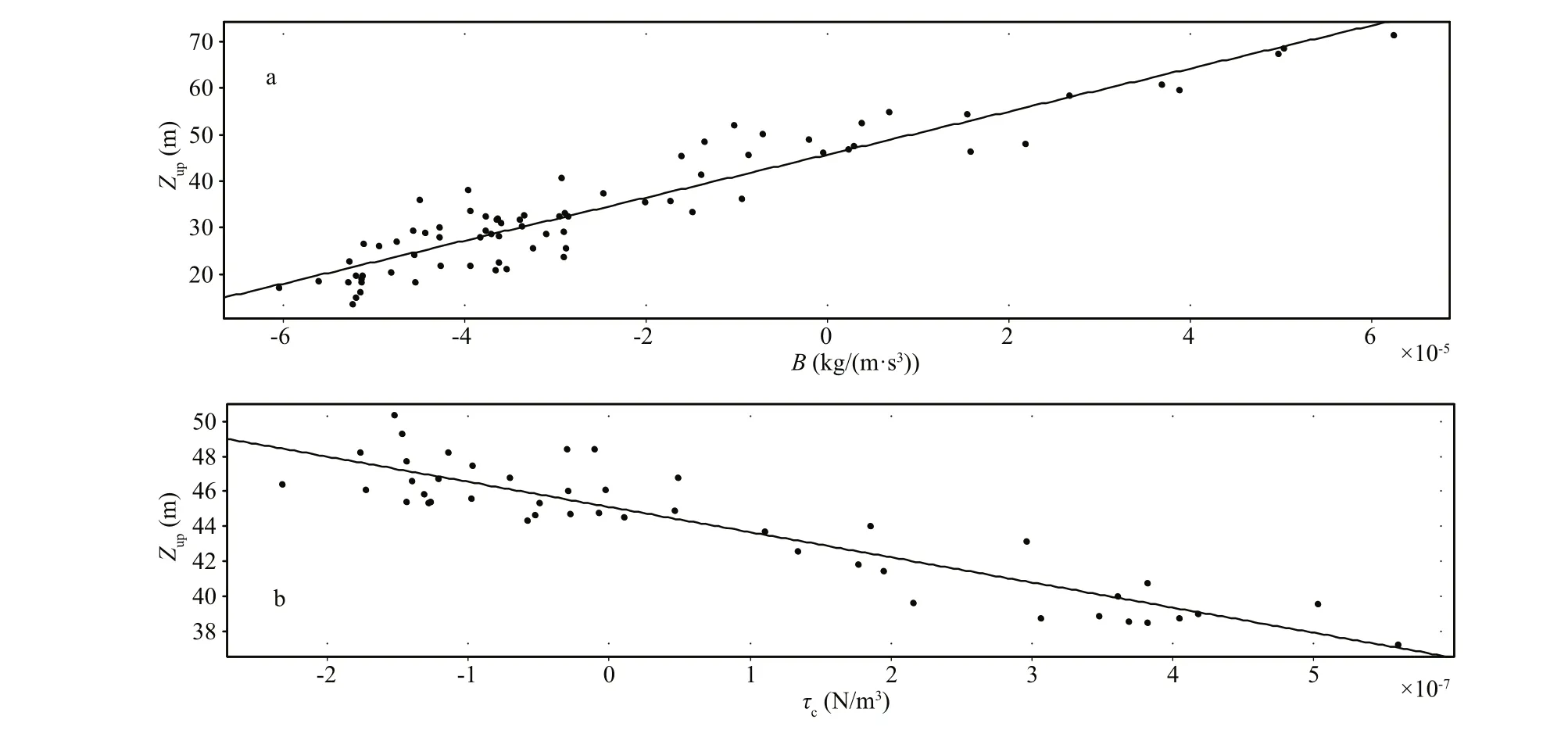
Fig.6 Linear regression of the buoyancy flux ( B) and Z up (a), the wind stress curl ( τ c) and Z up (b)

Fig.7 The odd-monthly means (January to November) of Z up resulted from Eq.7
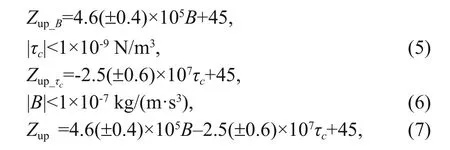
As mentioned above, the factors influencingZupare the buoyancy flux (B) and the wind stress curl (τc). To further explore the relative importance ofBandτconZup, we calculate the contribution ofBandτctoZupusing Eq.8, wherepmeans the contribution from the buoyancy flux and 100% minusprepresents the contribution from the wind stress curl.
As shown in Fig.8, most of theZupvalues are influenced by both the buoyancy flux and the wind stress curl from December to the following February when the wind stress curl dominates the SCS deep basin. The buoyancy flux controlsZupin most regions from April to November (Fig.8d–k), among whichZupis mainly affected by the buoyancy flux in May and June, while from July to September,Zupin the north of 12°N is mainly influenced by the buoyancy flux with the southern part being dominated by both the buoyancy flux and the wind stress curl.

5 CONCLUSION AND DISCUSSION
This study examines variability of the upper and lower boundaries of thermocline (ZupandZlow), its thickness (ΔZ) and intensity (Tz) in the SCS, and explores the mechanisms responsible for the monthly variability ofZup. The major results are summarized as follows.
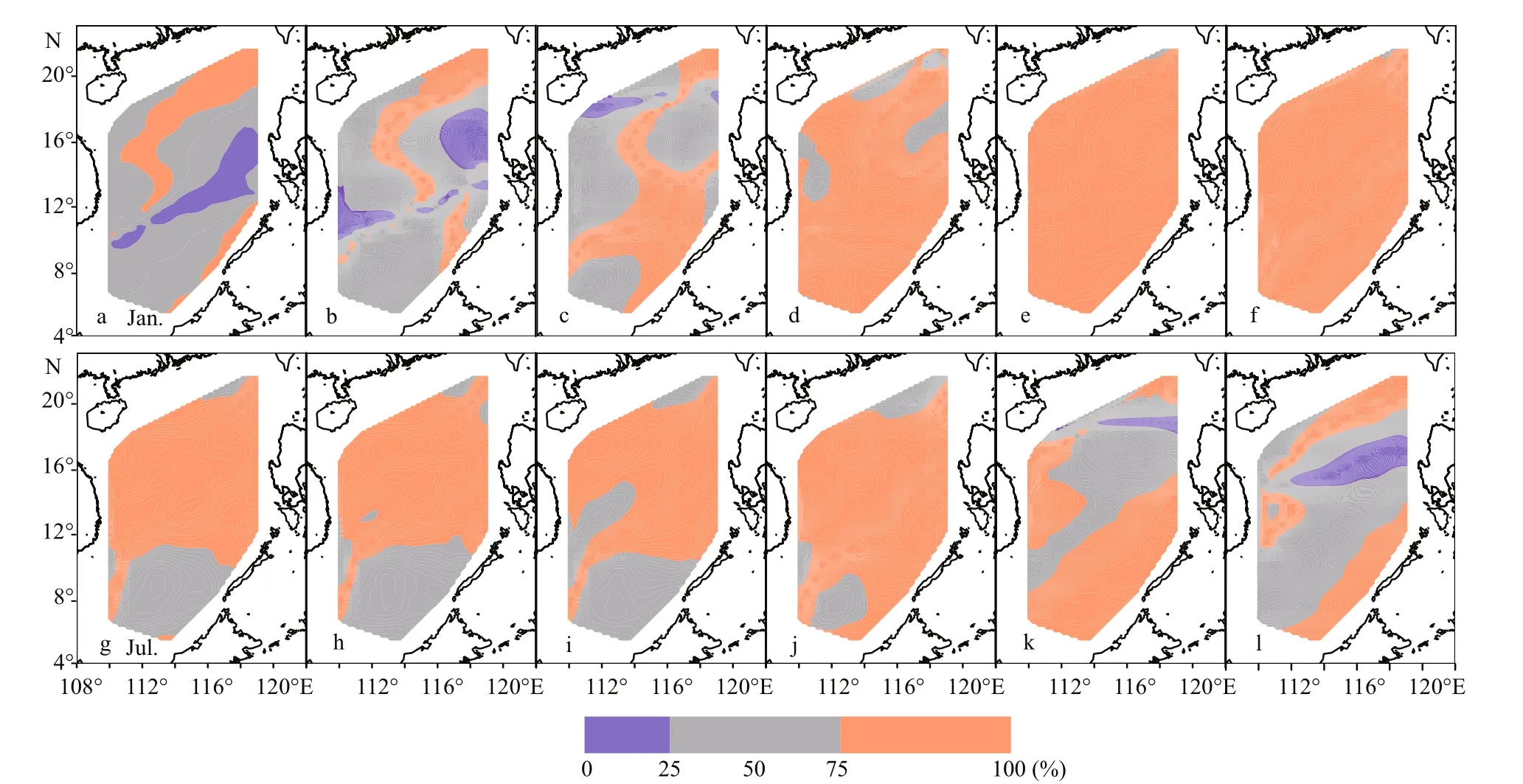
Fig.8 Distributions of p, Z up is primarily influenced by the wind stress curl when p <25%, by the buoyancy flux when p >75%,and by both when p >25% and p <75%, (a) to (l) is January to December
The climatological monthly meanZup,Zlow, ΔZandTzof the SCS are directly or indirectly determined by the vertical temperature GC method from monthly seawater temperature data (1960–2010). The results show that the spatial mean ofZupgradually shoals from February to May and deepens from May to the following January, ΔZis out of phase withZupbecauseZlowremains unchanged all year round.
This study reveals that both the surface buoyancy flux and the wind stress curl play dominant roles in monthly variability ofZup. The variability of surface buoyancy flux (B) resulting from net heat and fresh water flux variations can lead to mix the surface water and change the thickness of the mixed layer, so as to affect the depth of thermocline. The wind stress curl(τc) has the ability to influenceZupthrough generating upwelling or downwelling. In order to explore howBandτcquantitatively affectZup, we investigate the monthlyBbased on the heat flux and precipitation data from NCEP, the evaporation data provided by the Woods Hole Oceanographic Institution, and theτcaccording to wind stress data from SODA. The results reveal thatZupshows the best correlation to onemonth-advancedBand two-month-advancedτc.
We have analyzed the effects ofBandτconZupand obtained the regression equation:Zup=4.6(± 0.4)×105B–2.5(± 0.6)×107τc+45, which means thatZuphas positive correlation withBand negative correlation withτc.Zupdeepens from 4.2 m to 5.0 m (mean 4.6 m) whenBincreases by 1×10-5kg/(m·s3) without consideringτc,and shoals from 1.9 m to 3.1 m (mean 2.5 m) whenτcincreases by 1×10-7N/m3regardless ofB. The relative importance of the buoyancy flux and the wind stress curl toZupis also examined, indicating thatZupis mainly controlled by the buoyancy flux throughout the whole year.
Although the Eq.7, resulting from a linear method,can quantitatively account for the influence ofBandτconZup, there are still some points remaining for discussion. Before using a linear method, the grid points ofZupandB,Zupandτcin the SCS must be the same.Zupandτcwhich are calculated from SODA products with a 0.5°×0.5° horizontal resolution have the same grid points, butBwhich is calculated from NCEP (1.875°×1.875°), NOAA (2.5°×2.5°) and WHOI (1°×1°) products has a much fewer grid points thanZup. Therefore, we use the 2-D interpolation method to makeBa 0.5°×0.5° horizontal resolution before analyzing the relationship betweenBandZup.This may have distorted the Eq.7 somewhat because some grid points ofBare from interpolation which could not represent the observations. Moreover, the wind stress (not the wind stress curl) on the sea surface can generate and maintain turbulence to the upper ocean, which would also influence the depth of mixed layer and thermocline. We will take into account the influence of wind stress onZupin our next step.
6 ACKNOWLEDGEMENT
We thank professor John Hodgkiss of the University of Hong Kong for his help with English.
Carton J A, Chepurin G, Cao X H, Giese B. 2000a. A simple ocean data assimilation analysis of the global upper ocean 1950-95. Part I: methodology.J.Phys.Oceanogr.,30(2):294-309.
Carton J A, Chepurin G, Cao X H. 2000b. A simple ocean data assimilation analysis of the global upper ocean 1950-95.Part II: results.J.Phys.Oceanogr.,30(2): 311-326.
Carton J A, Giese B S, Grodsky S A. 2005. Sea level rise and the warming of the oceans in the Simple Ocean Data Assimilation (SODA) ocean reanalysis.J.Geophys.Res.,110(C9): C09006, https://doi.org/10.1029/2004JC002817.
Carton J A, Giese B S. 2008. A reanalysis of ocean climate using Simple Ocean Data Assimilation (SODA).Mon.Wea.Rev.,136(8): 2 999-3 017.
Chen M Y, Xie P P, Janowiak J E, Arkin P A. 2002. Global land precipitation: a 50-yr monthly analysis based on gauge observations.J.Hydrometeorol.,3(3): 249-266.
China State Bureau of Technical Supervision (CSBTS). 2008.GB/T 12763.7-2007 The specifications for oceanographic survey—Part 7: exchange of oceanographic survey data.China Standards Press, Beijing. (in Chinese)
Fang X J, Wang C X, Xu J J. 2013. Seasenal and interannual variations of the thermocline depth in the South China Sea.Trans.Oceanol.Limnol., (3): 45-55. (in Chinese with English abstract)
Fofonoff P, Millard Jr R C. 1983. Algorithms for computation of fundamental properties of seawater. UNESCO Tech.Papers in Marine Science 44, UNESCO. 53p.
Ge R F, Qiao F L, Yu F, Jiang Z X, Guo J S. 2003. A method for calculating thermocline characteristic elements in shelf sea area—Quasi-step function approximation method.Adv.Mar.Sci.,21(4): 393-400. (in Chinese with English abstract)
Giese B S, Ray S. 2011. El Niño variability in simple ocean data assimilation (SODA), 1871-2008.J.Geophys.Res.,116(C2): C02024, https://doi.org/10.1029/2010JC006695.
Gill A E. 1982. Atmosphere-Ocean Dynamics. Academic Press, San Diego, USA.
Hao J J, Chen Y L, Wang F, Lin P F. 2012. Seasonal thermocline in the China Seas and northwestern Pacific Ocean.J.Geophys.Res,117(C2): C02022, https://doi.org/10.1029/2011JC007246.
Hao J J, Chen Y L, Wang F. 2008. A study of thermocline calculations in the China Sea.Mar.Sci.,32(12): 17-24. (in Chinese with English abstract)
Kalnay E, Kanamitsu M, Kistler R, Collins W, Deaven D,Gandin L, Iredell M, Saha S, White G, Woollen J, Zhu Y,Leetmaa A, Reynolds B, Chelliah M, Ebisuzaki W,Higgins W, Janowiak J, Mo K C, Ropelewski C, Wang J,Jenne R, Joseph D. 1996. The NCEP/NCAR 40-year reanalysis project.Bull.Amer.Meteor. Soc.,77(3): 437-472.
Lan J, Bao Y, Yu F, Sun S W. 2006. Seasonal variabilities of the circulation and thermocline depth in the South China Sea deep water basin.Adv.Mar.Sci.,24(4): 436-445. (in Chinese with English abstract)
Liu Q Y, Jia Y L, Liu P H, Wang Q, Chu P C. 2001. Seasonal and intraseasonal thermocline variability in the central South China Sea.Geophys.Res.Lett.,28(23): 4 467-4 470.
Liu Q Y, Yang H J, Wang Q. 2000. Dynamic characteristics of seasonal thermocline in the deep sea region of the South China Sea.Chin.J.Oceanol.Limnol.,18(2): 104-109.
Lozovatsky I, Figueroa M, Roget E, Fernando H J S,Shapovalov S. 2005. Observations and scaling of the upper mixed layer in the North Atlantic.J.Geophys.Res.,110(C5): C05013, https://doi.org/10.1029/2004JC002708.
McDougall T J. 1987. Neutral surfaces.J.Phys.Oceanogr.,17(11): 1 950-1 964.
Schmitt R W, Bogden P S, Dorman C E. 1989. Evaporation minus precipitation and density fluxes for the North Atlantic.J.Phys.Oceanogr.,19(9): 1 208-1 221.
Yu L S, Jin X Z, Weller R A. 2008. Multidecade global flux datasets from the objectively analyzed air-sea fluxes(OAFlux) project: latent and sensible heat fluxes, ocean evaporation, and related surface meteorological variables.Woods Hole Oceanographic Institution, OAFlux Project Technical Report. OA-2008-01, Woods Hole,Massachusetts, USA. 64p.
Zhou F X, Gao R Z. 2001. Intraseasonal variability of the subsurface temperature observed in the South China Sea(SCS).Chin.Sci.Bull.,47(4): 337-342.
猜你喜欢
杂志排行
Journal of Oceanology and Limnology的其它文章
- Editorial Statement
- Hydroacoustic estimates of fish biomass and spatial distributions in shallow lakes*
- A comparison between benthic gillnet and bottom trawl for assessing fish assemblages in a shallow eutrophic lake near the Changjiang River estuary*
- Morphological beak differences of loliginid squid, Uroteuthis chinensis and Uroteuthis edulis, in the northern South China Sea*
- Muelleria pseudogibbula, a new species from a newly recorded genus (Bacillariophyceae) in China*
- Planaxidae (Mollusca, Gastropoda) from the South China Sea*
